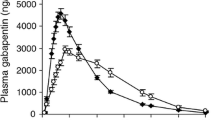Abstract
Epilepsy is a chronic disorder that requires adherence to long term anticonvulsant drug therapy for successful outcomes. Most established anticonvulsants must be taken several times a day because of short half-lives and narrow therapeutic indices. Extended release (ER) formulations of some anticonvulsants have been developed to reduce dose frequency and to maintain constant plasma drug concentrations, and to reduce adverse effects.
For a drug to be a suitable candidate for ER formulation it must possess the following characteristics: a short half-life, no first-pass metabolism, a narrow therapeutic index, and efficient absorption throughout the gastrointestinal tract. Of the currently available anticonvulsants, carbamazepine and valproic acid (sodium valproate) are the most suitable candidates for ER formulation.
Several carbamazepine ER formulations have been developed. These formulations include Carbatrol®, Tegretol-XR®, Tegretol Retard®, Neurotol Slow®, Trimonil Retard® and Teril CR®, among others. Valproic acid ER formulations have also been developed. Although there are currently no ER formulations of valproic acid marketed in the US, several are available in Europe including Epilim Chrono® and Depakine Chrono®. The Depakote Sprinkle® formulation is also available in some European countries.
Of the newer anticonvulsants tiagabine is the most likely candidate for future ER formulation.
ER formulations offer the advantage of better patient compliance due to decreased frequency of administration and adverse effects. Also, less fluctuation in plasma concentrations makes monitoring of drug concentrations more viable. These advantages should lead to better seizure control and improve quality of life for the patient.






Similar content being viewed by others
References
Hauser WA, Annegers JF, Rocca WA. Descriptive epidemiology of epilepsy: contributions of population-based studies from Rochester, Minnesota. Mayo Clinic Proc 1996; 71: 576–86
Garnett WR. Epilepsy. In: Dipiro JT, Talbert RL, Yee GC, et al., editors. Pharmacotherapy. 3rd ed. Stamford (CT): Appleton and Lange, 1997: 1179–209
Cramer JA, Mattson RH, Prevey ML, et al. How often is medication taken as prescribed? A novel assessment technique. JAMA 1989; 261: 3273–7
Bialer M. Pharmacokinetic evaluation of sustained release formulations of antiepileptic drugs. Clin Pharmacokinet 1992; 22(1): 11–21
Bialer M, Cloyd JC. General principles: formulations and route of administration. In: Levy RH, Mattson RH, Meldrum BS, editors. Antiepileptic drugs, 4th ed. New York (NY): Raven Press, 1995: 161–78
Walker MC, Patsalos PN. Clinical pharmacokinetic s of new antiepileptic drugs. Pharmac Ther 1995; 67(3): 351–84
Morselli PL. Carbamazepine: absorption, distribution, and excretion. In: Levy RH, Mattson RH, Meldrum BS, editors. Antiepileptic drugs. 4th ed. New York (NY): Raven Press, 1995: 515–28
Garnett WR, Huffman JL, Doyle J, et al. Administration of carbatrol® (carbamazepine extended-release capsules) via feeding tubes [abstract 2.055]. Epilepsia 1999; 40 Suppl. 7: 98
Riss JR, Kriel RL, Kammer N, et al. Occlusion of feeding gastrostomy tubes with extended-release carbamazepine capsules [abstract 2.232]. Epilepsia 1999; 40 Suppl. 7: 141
Garnett WR, Levy B, McLean AM, et al. Pharmacokinetic evaluation of twice-daily extended-release carbamazepine and four-times-daily immediate-release carbamazepine in patients with epilepsy. Epilepsia 1998; 39(3): 274–9
Mirza WU, Rak IW, Thadani VM, et al. Six-month evaluation of Carbatrol (extended-release carbamazepine) in complex partial seizures. Neurology 1998; 51: 1727–9
Theeuwes F. Elementary osmotic pump. J Pharm Sci 1975; 64: 1987–91
Ansel HC, Popovich NG, Allen LV. Peroral solids, capsules, tablets, and controlled-release dosage forms. In: Balado DM, Klass FM, Carley PJ, et al., editors. Pharmaceutical dosage forms and drug delivery systems. 6th ed. Philadelphia (PA): Williams and Wilkins, 1995: 155–225
Thakker KM, Mangat S, Garnett WR, et al. Comparative bioavailability and steady state fluctuations of Tegretol commercial and carbamazepine OROS tablets in adult and pediatric epileptic patients. Biopharm Drug Dispos 1992; 13: 559–69
Wilding IR, Davis SS, Hardy JG, et al. Relationship between systemic drug absorption and gastrointestinal transit after the simultaneous oral administration of carbamazepine as a controlled-release system and as a suspension of 15N-labelled drug to healthy volunteers. Br J Clin Pharmacol 1991; 32: 573–9
The Tegretol OROS Osmotic Release Delivery System Study Group. Double-blind crossover comparison of Tegretol-XR and Tegretol in patients with epilepsy. Neurology 1995; 45: 1703–7
Stevens RE, Limsakun T, Evans G, et al. Controlled, multidose, pharmacokinetic evaluation of two extended-release carbamazepine formulations (Carbatrol and Tegretol-XR). J Pharm Sci 1998; 87(12): 1531–4
Jensen PK, Moller A, Gram L, et al. Pharmacokinetic comparison of two carbamazepine slow-release formulations. Acta Neurol Scand 1990; 82: 135–7
Eeg-Olofsson O, Nilsson HL, Tonnby B, et al. Diurnal variation in carbamazepine and carbamazepine 10, 11-expoxide in plasma and saliva in children with epilepsy: a comparison between conventional and slow-release formulations. J Child Neurol 1990; 5: 159–65
Sivenius J, Heinonen E, Lehto H, et al. Reduction of dosing frequency of carbamazepine with a slow release preparation. Epilepsy Res 1988; 2: 32–6
Reunanen M, Heinonen E, Anttila M, et al. Multiple-dose pharmacokinetic study with slow-release carbamazepine preparation. Epilepsy Res 1990; 6: 126–33
Larkin JG, McLellan A, Munday A, et al. A double blind comparison of conventional and controlled-release carbamazepine in healthy subjects. Br J Clin Pharmacol 1989; 27: 313–22
Bialer M, Arcavi L, Sussan S, et al. Existing and new criteria for bioequivalence evaluation of new controlled release (CR) products of carbamazepine. Epilepsy Res 1998; 32: 371–8
Bialer M, Yacobi A, Moros D, et al. Criteria to assess in vivo performance and bioequivalence of generic controlled-release formulations of carbamazepine. Epilepsia 1998; 39(5): 513–9
Bialer M, Friedman M, Dubrovsky J. Pharmacokinetic evaluation of novel sustained-release dosage forms of valproic acid in humans. Biopharm Drug Dispos 1985; 6: 401–11
Roberts D, Easter D, O’Bryan-Tear G. Epilim® Chrono: a multi-dose, crossover comparison of two formulations of valproate in healthy volunteers. Biopharm Drug Dispos 1996; 17: 175–82
Cloyd JC, Kriel RL, Jones-Saete CM, et al. Comparison of sprinkle versus syrup formulations of valproate for bioavailability, tolerance, and preference. J Pediatrics 1992; 120(4): 634–8
Author information
Authors and Affiliations
Corresponding author
Rights and permissions
About this article
Cite this article
Collins, R.J., Garnett, W.R. Extended Release Formulations of Anticonvulsant Medications. Mol Diag Ther 14, 203–212 (2000). https://doi.org/10.2165/00023210-200014030-00003
Published:
Issue Date:
DOI: https://doi.org/10.2165/00023210-200014030-00003




